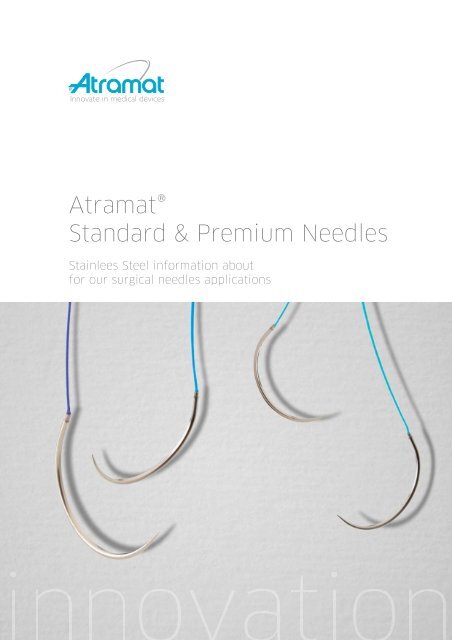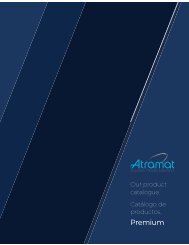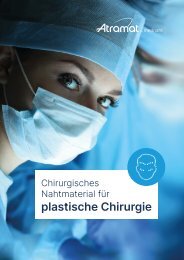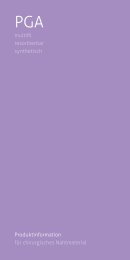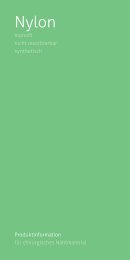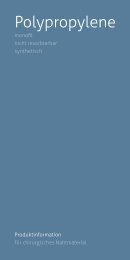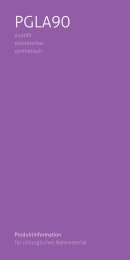Atramat® Needle-Steel Info
Create successful ePaper yourself
Turn your PDF publications into a flip-book with our unique Google optimized e-Paper software.
<strong>Atramat®</strong><br />
Standard & Premium <strong>Needle</strong>s<br />
Stainlees <strong>Steel</strong> information about<br />
for our surgical needles applications
Overview<br />
INTRODUCTION Page 3<br />
WHO MANUFACTURES WHAT ? Page 4<br />
MARTENSITIC STAINLESS STEELS Page 6<br />
AUSTENITIC STAINLESS STEELS Page 7<br />
QUALITATIVE OVERVIEW OF THE PERFORMANCES<br />
STEEL BY STEEL Page 8<br />
HARDNESS Page 9<br />
CORROSION RESISTANCE Page 9<br />
BENDING RESISTANCE AND DUCTILITY COMPORTMENT Page 10<br />
TAPER POINT NEEDLES<br />
GENERAL RECAP Page 11<br />
2
About the <strong>Steel</strong> in our needles<br />
Nowadays, all over the world, the production of surgical needles is usually made of stainless<br />
steels. A stainless steel means a steel containing chromium (Cr). The main function of this<br />
chromium addition is to increase the corrosion resistance of the steel.<br />
Surgical needles have complicated shape and should present the best compromise between<br />
higher final strength, no breakage during use, good attaching for the suture thread and good<br />
constant penetration in the tissues.<br />
In order to manufacture surgical needles, we can find 2 main stainless steels families:<br />
Martensitic<br />
Austenitic<br />
3
Who manufactures what<br />
Martensitic :<br />
AISI 420 and 420 F series<br />
Sometimes called «A » grade<br />
<strong>Atramat®</strong> Standard <strong>Needle</strong>s<br />
ETHICON<br />
TYCO<br />
Austenitic : AISI 301 - 302 - 304<br />
<strong>Atramat®</strong> Premium <strong>Needle</strong>s<br />
MANI<br />
ETHICON<br />
The above is not an exhaustive list of the steels available on the market<br />
4
About our <strong>Needle</strong>s<br />
nnovation
<strong>Atramat®</strong> Standard <strong>Needle</strong>s<br />
Martensitic Stainless <strong>Steel</strong><br />
Examples:<br />
AISI 420 : Z 35 C14 AISI 420 F : Z 22 CD 13-1<br />
Their general chemical composition is:<br />
CARBON : From 0,1 to 0,4 %<br />
CHROMIUM : From 11,5 to 14,5 %<br />
Some additional elements can be added to slightly modify the performance of the stainless<br />
steel. Sulphur provides an easier drillability and molybdenum increases the corrosion<br />
resistance.<br />
Thanks to their very good formability and drillability, the martensitic chromium stainless<br />
steels have been the most widely used in the market.<br />
This stainless steel family reaches its mechanical characteristics, and its corrosion resistance<br />
after heat treatment.<br />
The hardening process is obtained by heating and air quenching (quick cooling) the metal,<br />
followed by a tempering operation.<br />
After quenching : we obtain a martensitic microstructure.<br />
Heating<br />
Quenching<br />
KEY INFORMATION<br />
1. The basic stainless steel of the market<br />
2. Certainly the easiest machinability<br />
3. Main drawback :<br />
The choice of parameters that balances the different performances (High Bending<br />
Resistance, Ductilty, Easy attaching, Good Corrosion Resistance) is very limited.*<br />
6
<strong>Atramat®</strong> Premium <strong>Needle</strong>s<br />
Austenitic Stainless <strong>Steel</strong><br />
This the family of the AISI 300 Stainless steels, used in the <strong>Atramat®</strong> Premium range<br />
of needles. This family of steels is used by MANI and ETHICON (for high quality sutures).<br />
Examples:<br />
AISI 304 : X5 Cr Ni 18-10 AISI 302 : X10 Cr Ni 18-8<br />
Their general chemical composition is:<br />
CARBON : < 0.15 %<br />
NICKEL : From 6 to 13 %<br />
CHROMIUM : From 17 to 20 %<br />
Additional elements : Molybdenum, Copper, Manganese<br />
Due to their chemical composition, the structure of these stainless steel grades is fully<br />
austenitic at low and high temperatures.<br />
It is the austenitic structure that gives the ductile comportment of the needle.<br />
Thanks to the important chromium content, these steels have an excellent corrosion<br />
resistance. For example, they can be used in surgical implants.<br />
The mechanical resistance of the austenitic stainless steels is given by a strong cold<br />
working.<br />
During a strong cold working, the carbon atoms penetrate the austenic structure, creating a<br />
solid solution that strongly strengthens the wire.<br />
Cold working<br />
Soft austenite<br />
Harder austenite<br />
It is its specific structure that gives the 300 stainless steels their excellent mechanical<br />
performances for needle application. These performances are today the best on the market.<br />
The formability and the drillability of such stainless steels is really difficult, and need a<br />
specific process.<br />
To achieve the perfect adequacy between high tensile strength and ductility, a perfect<br />
knowledge of the raw material elaboration linked to the specific know-how of the needle<br />
manufacturer is required .<br />
The <strong>Atramat®</strong> Premium <strong>Needle</strong> bending resistance is improved by more than 40% compared<br />
to a classical 420F martensitic taper point needle, while maintaining an excellent ductility.<br />
KEY INFORMATION<br />
1. The best steel on the market<br />
2. Most difficult machinability<br />
3. Main advantage:<br />
Combine high bending resistance with high ductility.<br />
7
QUALITATIVE OVERVIEW OF THE PERFORMANCES<br />
Characteristics<br />
Bending<br />
Resistance<br />
Martensitic<br />
420<br />
+<br />
Austenitic<br />
300<br />
From ++ to +++<br />
Ductility +<br />
+++<br />
Corrosion<br />
Resistance<br />
+ +++<br />
Hardness +<br />
From ++ to +++<br />
+ Good + + Very Good + + + Excellent<br />
8
HARDNESS<br />
HARDNESS Vickers (Hv)<br />
700<br />
650<br />
Premium <strong>Needle</strong>s<br />
Series<br />
600<br />
550<br />
500<br />
420 F<br />
Standard <strong>Needle</strong>s<br />
Series<br />
450<br />
Martensitic<br />
420<br />
Austenitic<br />
300<br />
The strong hardness of the <strong>Atramat®</strong> Premium Neecles optimizes their wear<br />
resistance, and their mechanical performances.<br />
This very high hardness contributes to maintain the good penetration<br />
characteristics of the needles throughout the surgical act.<br />
CORROSION RESISTANCE<br />
200<br />
180<br />
160<br />
140<br />
120<br />
100<br />
80<br />
60<br />
40<br />
20<br />
0<br />
Martensitic<br />
420<br />
Martensitic<br />
420<br />
Austenitic<br />
300<br />
Austenitic<br />
300<br />
9
Bending resistance and ductility<br />
TAPER POINT NEEDLES<br />
The <strong>Atramat®</strong> Premium <strong>Needle</strong> bending resistance is<br />
improved by:<br />
more than 40% compared to a classical 420F martensitic<br />
taper point needle, with an excellent ductility.<br />
<strong>Atramat®</strong> Premium <strong>Needle</strong>: the highest quality needle.<br />
10
General Recap<br />
<strong>Atramat®</strong> Premium <strong>Needle</strong>s (300 series)<br />
HARDNESS: 50% higher than 420<br />
BENDING RESISTANCE: 40% higher than 420<br />
DUCTILITY: More than 4 times better than 420<br />
11


